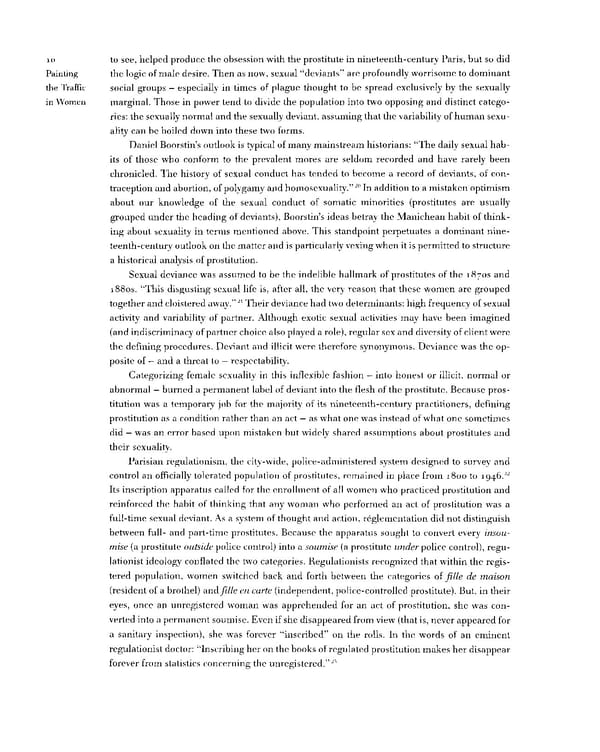10 to see, helped produce the obsession with the prostitute in nineteenth-century Paris, but so did Painting the logic of male desire. Then as now, sexual "deviants" are profoundly worrisome to dominant the Traffic social groups — especially in times of plague thought to be spread exclusively by the sexually in Women marginal. Those in power tend to divide the population into two opposing and distinct catego- ries: the sexually normal and the sexually deviant, assuming that the variability of human sexu- ality can be boiled down into these two forms. Daniel Boorstin's outlook is typical of many mainstream historians: "The daily sexual hab- its of those who conform to the prevalent mores are seldom recorded and have rarely been chronicled. The history of sexual conduct has tended to become a record of deviants, of con- 20 traception and abortion, of polygamy and homosexuality." In addition to a mistaken optimism about our knowledge of the sexual conduct of somatic minorities (prostitutes are usually grouped under the heading of deviants), Boorstin's ideas betray the Manichean habit of think- ing about sexuality in terms mentioned above. This standpoint perpetuates a dominant nine- teenth-century outlook on the matter and is particularly vexing when it is permitted to structure a historical analysis of prostitution. Sexual deviance was assumed to be the indelible hallmark of prostitutes of the 18705 and i88os. "This disgusting sexual life is, after all, the very reason that these women are grouped 21 together and cloistered away." Their deviance had two determinants: high frequency of sexual activity and variability of partner. Although exotic sexual activities may have been imagined (and indiscriminacy of partner choice also played a role), regular sex and diversity of client were the defining procedures. Deviant and illicit were therefore synonymous. Deviance was the op- posite of — and a threat to — respectability. Categorizing female sexuality in this inflexible fashion — into honest or illicit, normal or abnormal — burned a permanent label of deviant into the flesh of the prostitute. Because pros- titution was a temporary job for the majority of its nineteenth-century practitioners, defining prostitution as a condition rather than an act — as what one was instead of what one sometimes did — was an error based upon mistaken but widely shared assumptions about prostitutes and their sexuality. Parisian regulationism, the city-wide, police-administered system designed to survey and control an officially tolerated population of prostitutes, remained in place from 1800 to ig46.22 Its inscription apparatus called for the enrollment of all women who practiced prostitution and reinforced the habit of thinking that any woman who performed an act of prostitution was a full-time sexual deviant. As a system of thought and action, reglementation did not distinguish between full- and part-time prostitutes. Because the apparatus sought to convert every insou- mise (a prostitute outside police control) into a soumise (a prostitute under police control), regu- lationist ideology conflated the two categories. Regulationists recognized that within the regis- tered population, women switched back and forth between the categories of fille de maison (resident of a brothel) andfille en carte (independent, police-controlled prostitute). But, in their eyes, once an unregistered woman was apprehended for an act of prostitution, she was con- verted into a permanent soumise. Even if she disappeared from view (that is, never appeared for a sanitary inspection), she was forever "inscribed" on the rolls. In the words of an eminent regulationist doctor: "Inscribing her on the books of regulated prostitution makes her disappear 25 forever from statistics concerning the unregistered."
 Prostitution & Impressionists Page 30 Page 32
Prostitution & Impressionists Page 30 Page 32